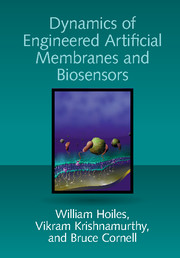Book contents
- Frontmatter
- Contents
- Preface
- List of Abbreviations
- Part I Introduction and Background
- Part II Building Engineered Membranes, Devices, and Experimental Results
- Part III Dynamic Models for Artificial Membranes: From Atoms to Device
- Appendices
- Appendix A Elementary Primer on Partial Differential Equations (PDEs)
- Appendix B Tutorial on Coarse-Grained Molecular Dynamics with Peptides
- Appendix C Experimental Setup and Numerical Methods
- Bibliography
- Index
Appendix B - Tutorial on Coarse-Grained Molecular Dynamics with Peptides
from Appendices
Published online by Cambridge University Press: 25 May 2018
- Frontmatter
- Contents
- Preface
- List of Abbreviations
- Part I Introduction and Background
- Part II Building Engineered Membranes, Devices, and Experimental Results
- Part III Dynamic Models for Artificial Membranes: From Atoms to Device
- Appendices
- Appendix A Elementary Primer on Partial Differential Equations (PDEs)
- Appendix B Tutorial on Coarse-Grained Molecular Dynamics with Peptides
- Appendix C Experimental Setup and Numerical Methods
- Bibliography
- Index
Summary
In this appendix we use GROMACS 5.1, PyMOL 1.7x, and VMD 1.9.3, together with the MARTINI force field to outline how to set up coarse-grained molecular dynamics (CGMD) simulations of a peptide. Our description includes how to construct the all-atom structure of the peptide, how to build all-atom models of bilayer lipid membranes, how to insert the peptides into the membrane, and how to construct publication-quality figures. The material in this appendix is relevant to Chapter 14 for constructing coarse-grained molecular dynamics simulations using the MARTINI force field. Note that performing CGMD simulations and MD simulations are identical except for the definitions of the bead-particle interactions and simulation time steps used. All the files associated with these tutorials are provided at www.cambridge.org/ engineered-artificial-membranes.
Constructing the All-Atom and Coarse-Grained Structure of a Peptide
This section illustrates how to construct the all-atom and coarse-grained structure of the antimicrobial PGLa peptide using VMD and PyMOL. Recall that molecular dynamics (MD) and PyMOL were discussed in Chapter 2, and PGLa was discussed in Chapter 10. The goal is to construct the all-atom and coarse-grained structures of PGLa illustrated in Figure B.1.
To construct the all-atom coordinate structure of the PGLa peptide the following steps are used.
(i)Obtain the amino-acid sequence of interest. For PGLa the amino acid sequence is:
GMASKAGAIAGKIAKVALKAL-NH2.
(ii) Open VMD, and proceed to Extensions → Modeling → Molfacture. Click the “Start Molefacture”, leaving the entry field blank.
(iii) In Molefacture, Build→Protein Builder. Enter the amino-acid sequence of PGLa, and select the α-helix secondary structure (this is the expected secondary structure of PGLa in both the surface and transmembrane configuration as discussed in Chapter 14). Now click build.
(iv) After pressing build, the all-atom structure of PGLa will appear in the VMD display. In VMD Main, select File→Save Coordinates, and save the all-atom PGLa structure as PGLa.pdb. The file PGLa.pdb contains the all-atom representation of the PGLa peptide in the protein data bank format.
Notice that this PGLa.pdb file can be viewed in both VMD and PyMOL.
Having constructed the PGLa.pdb coordinate file, we now map the all-atom structure into a coarse-grained structure for use with the MARTINI force field. This mapping operation is performed using the martinize.py python script (available from http://md.chem.rug.nl/cgmartini/index.php/home).
Information
- Type
- Chapter
- Information
- Dynamics of Engineered Artificial Membranes and Biosensors , pp. 404 - 411Publisher: Cambridge University PressPrint publication year: 2018
